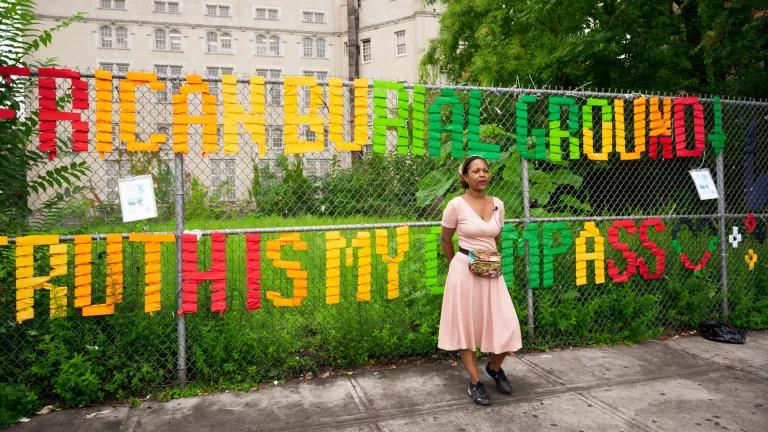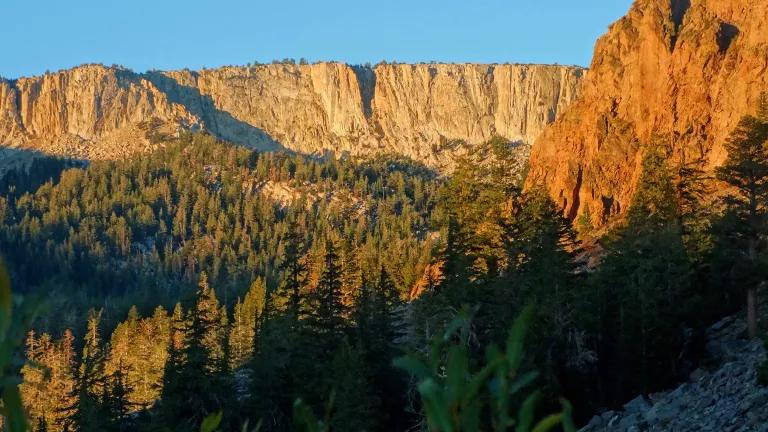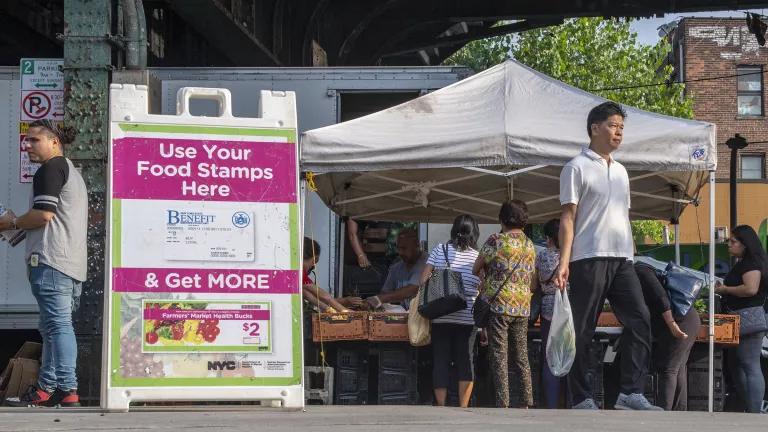Climate Week 2023: Indigenous Communities March with Determination
The fight against environmental harm, economic dependence, and negative health impacts from fossil fuel development on Indigenous land is a centuries-long tale.
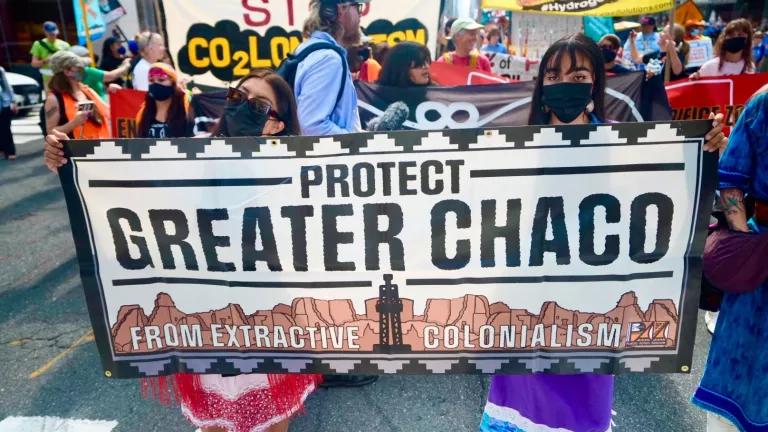
Greater Chaco Coalition members uplift the banner calling for the protection of the region from extractive industry.
John Acosta
During my early childhood in Bolivia, I grew up watching marches on the news led by Andean and Amazonian Indigenous communities asking for government protections to their lands from extractive industry. Through the screen, I could feel the passion from the march leaders and community members holding up banners, and it left a deep impression. In the decades that have followed, I continue to watch as Indigenous communities across the world demand respect for their sovereignty, protections for their sacred lands, and safe access to the environmental resources on which they depend.
This September, I joined in bringing these calls for basic rights and protections from the harms of fossil fuel extraction to the streets of New York City in the March to End Fossil Fuels. The clear demands and passion from the waves of Indigenous people and allies in attendance were reminiscent of those I saw televised in Bolivia as a young child.
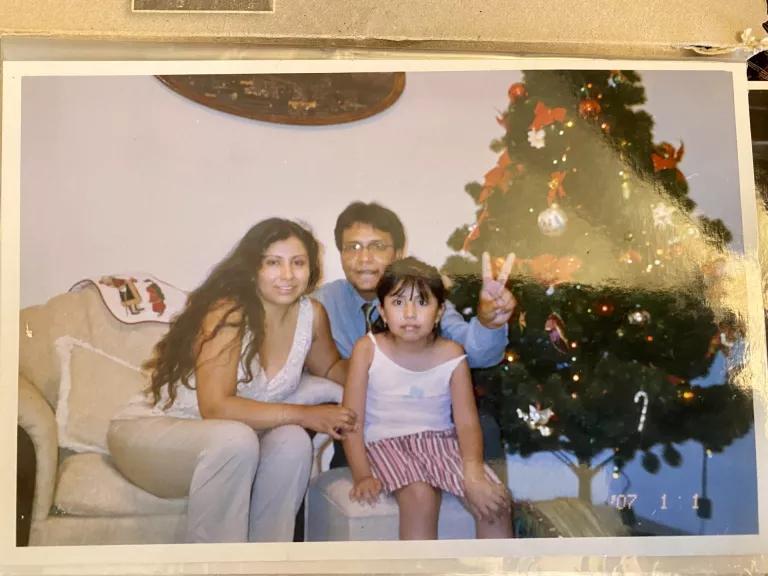
A 2007 holiday picture of myself (right), my mom (left), and my dad (center) in Santa Cruz, Bolivia.
Claudia Blanco Nunez
My mom and I migrated to New York City years ago, and she still resides in Queens, so I stayed with her to attend the march. Before I headed out, my mom told me about my dad’s experience as an attorney supporting his Indigenous clients at their marches in Bolivia. He specialized in Indigenous rights cases and, unbeknownst to me, had joined critical marches on foot across cities earlier in his career, showing support for Indigenous communities and their demands. I would sometimes join my dad on his travels to Guarani communities in the city of Santa Cruz and watch him meet with Tribal leaders to discuss how to best support their cases based on community needs. His client’s stories were among the first introductions I had to the disregard and colonization of Indigenous communities that continues into the present.
On the streets of Manhattan, I marched alongside the Greater Chaco Coalition, No False Solutions, Pueblo Action Alliance, Dine C.A.R.E, and other Indigenous-led and allied New Mexico organizations. Together, we sought increased protections from extractive industry development in the Greater Chaco region to prevent further pollution, harm to health, and destruction of natural environments. Despite the establishment of the Chaco Culture National Historical Park (CCNHP), enormous areas of Indigenous land in the Southwest remain unprotected from activities like oil and gas drilling. Recent analyses show that 91% of public lands in northwestern New Mexico have been leased for oil and gas drilling, with the remaining nine percent being in the Chaco region. This has meant that lands historically used by Indigenous communities, like Pueblo and Dine people, to practice their culture and access their ancestral lands, remain at risk. Among these, the Chaco Canyon holds more than 4,700 archeological artifacts belonging to Southwest Pueblos and Native Nations in the area who cherish these as part of their heritage. For these reasons, community members and allies have kept up their calls for a further buffer around the CCNHP to ensure that irreplaceable ancestral sites remain open and undisturbed.
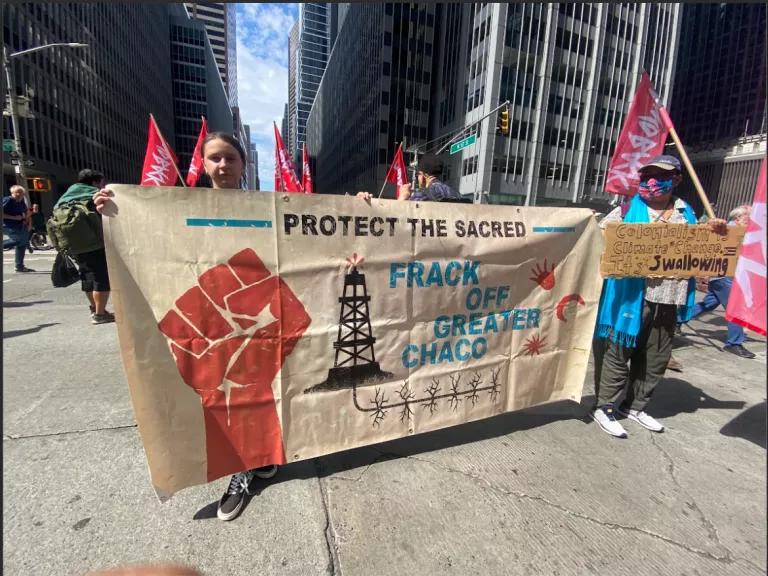
Protestors hold banners calling for greater protections for the Greater Chaco region in New Mexico.
Claudia Blanco Nunez
On June 2nd, 2023, Secretary of the Interior Deb Haaland heeded these decades-old calls and took action to approve the ten-mile buffer around the CCNHP. After the announcement of the ten-mile buffer, opposing actors have since launched an intrusive and irrelevant investigation on Pueblo Action Alliance and Secretary Haaland, in an attempt to delay the order that will bar further oil and gas leasing and mineral claims on the land for 20 years. These efforts have so far been unsuccessful, and the order continues to remain in effect.
To counter these attacks on protections of the Greater Chaco region, in July frontline community members of the Navajo Nation and members of the Greater Chaco Coalition submitted written testimony opposing H.R. 4374, a piece of proposed legislation known as the Energy Opportunities for All Act. Some members and leadership of the impacted regions of the Navajo Nation also traveled to Washington D.C. and testified against the legislation. The All Pueblo Council of Governors also traveled to Washington D.C. in mid-September to oppose H.R. 4374. If passed, it would completely jeopardize the Honoring Chaco Initiative and continue the status quo of exposing Indigenous and frontline communities in the Greater Chaco region to further air pollution, decreased quality of life, and loss of ancestral lands and resources from continued fossil fuel projects. The fight is ongoing, and hence a delegation of more than 50 New Mexicans traveled to New York City, taking the stand at Climate Week to continue the fight for more land protections for Greater Chaco, its residents, and its critical ecosystems.
I met some members and leaders of the Coalition by the “Love” sculpture in Manhattan, which remained the core of the march and the reason why attendees had traveled thousands of miles to take part in the march. I carried essentials like water and an ID in my Awayu cloth bag from Bolivia. The bag’s handwoven pattern is a representation of my Andean Indigenous heritage and a sign of my solidarity with the Indigenous people in the Chaco region and all similar fights for Indigenous land sovereignty and justice.

The Awayu bag I brought with me to the March to End Fossil Fuels.
Claudia Blanco Nunez
While we waited for the march to commence, we organized and gathered some coalition members who wanted to explain why they were at the March to End Fossil Fuels on the Greater Chaco Coalition’s new TikTok account (@frackoffchaco). According to the tracker tool managed by Earthworks and FracTracker Alliance, about 144,000 New Mexicans live within one-half mile of an oil and gas production facility. Among those who participated in this video project were a Tribal elder, an Indigenous organization leader, and allied members. All called for justice for the communities most impacted by the dependence on a fossil fuel economy. One of the participants who chose to share was Samuel Sage, Navajo Nation Community Services Coordinator. He expressed that the Navajo “people are heavily impacted by extraction, and...every day they have to live with all the toxic fumes and pollution and destruction fossil fuels industry causes...” Another participant, ally Rebecca Sobel from WildEarth Guardians, called out the irony that New Mexico’s public education system, partially funded by royalties and severance taxes from oil and gas development, ranked the lowest among all other states based on the 2022 National Assessment of Educational Progress test.
The march began after these interviews, and volunteers and community members raised their banners and handmade signs. Spectators on the crowded sidewalks took pictures, read each of the diverse banners and signs, and listened to the chants for “No false solutions!” and “Fossil fuels have got to go!” Throughout the march, I noticed a persistent feeling of comradery and solidarity between people of different organizations, groups, and concerned individuals. Most striking was the visibility of Indigenous people from different regions and continents in one space, represented across age groups and generations fighting for the common goals of Indigenous sovereignty, respect, and healthy people, environments, and wildlife.

Protestors hold banners calling for Indigenous solidarity in New Mexico and a stop to further fossil fuel development on Indigenous lands.
Pueblo Action Alliance
This connectivity across groups stood out to me after spotting several Wiphala flags in the crowd. The Wiphala flag represents Andean Indigenous communities in Bolivia, Chile, and Peru. It is a symbol of resistance against colonial systems of oppression like systemic racism, classism, and environmental injustice. This was the same flag I saw countless times in the marches televised in Bolivia among the Andean Indigenous people’s fight for governmental representation and rights to their ancestral lands.
This year, the March to End Fossils saw a total of about 75,000 attendees. The New Mexico organizations and community members I stood alongside represent millions of people harmed by global fossil fuel development day after day. These people understand their state’s financial dependence on fossil fuel funding, but they also know there are more sustainable and reliable economic systems and energy sources that don’t place marginalized communities at continued risk of harm. They hope their presence at the march this year proves their fight is one shared deeply by Indigenous people across the globe, and that justice for one is a victory for all.


